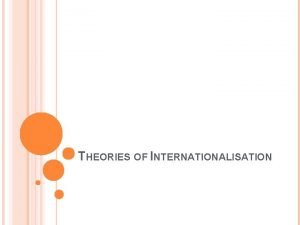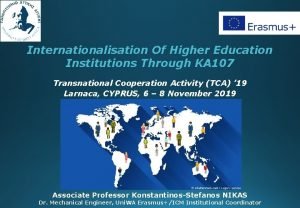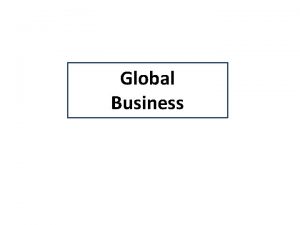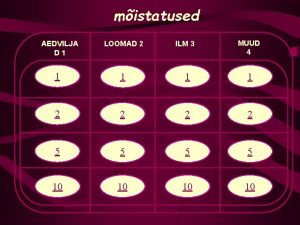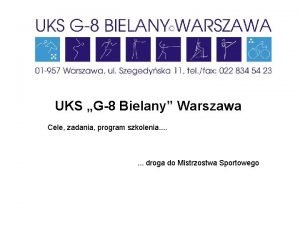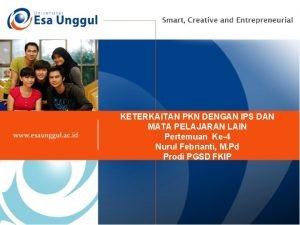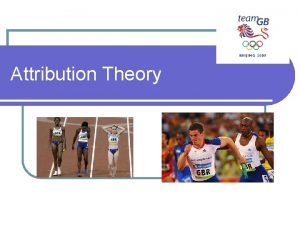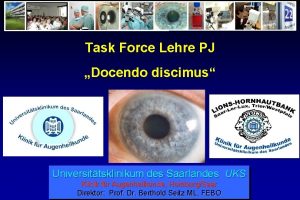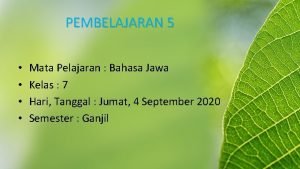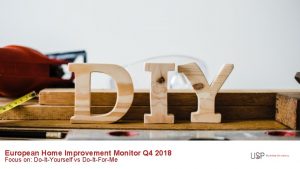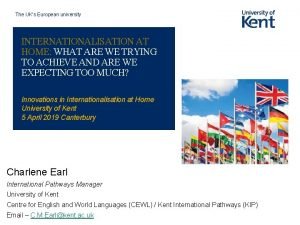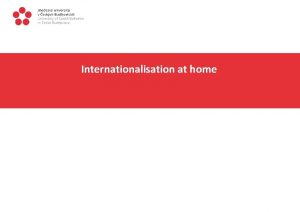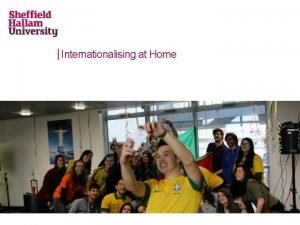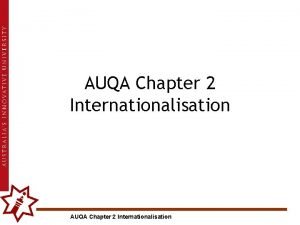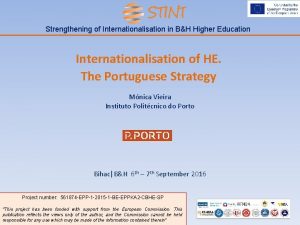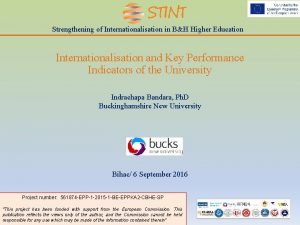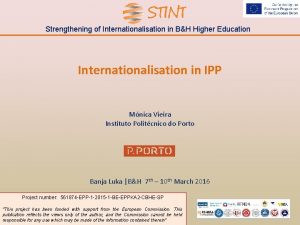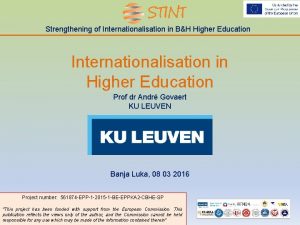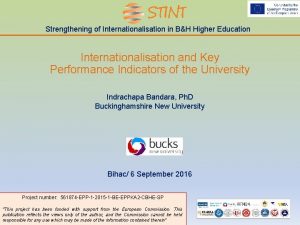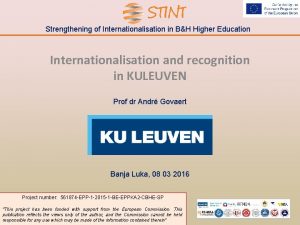The UKs European university INTERNATIONALISATION AT HOME WHAT














- Slides: 14

The UK’s European university INTERNATIONALISATION AT HOME: WHAT ARE WE TRYING TO ACHIEVE AND ARE WE EXPECTING TOO MUCH? Innovations in Internationalisation at Home University of Kent 5 April 2019 Canterbury Charlene Earl International Pathways Manager University of Kent Centre for English and World Languages (CEWL) / Kent International Pathways (KIP) Email – C. M. Earl@kent. ac. uk

Overview Brief overview: • • • Background context What does the research say? What are we trying to achieve? Activities: • • Examples of internationalisation at home activities What are the key foundations and objectives for successful internationalisation programmes and events? What are the key learning outcomes and do we measure them? Are we expecting too much?

Background context • • Late 1990 s, Nilson (2003), Malmö University, Sweden Internationally-focused on-campus activities Aim: to extend beyond mobility aimed at the whole student body to encourage interaction: domestic and international students to gain deeper cross-cultural awareness Internationalisation at home / Internationalisation of the curriculum

Background context “Internationalisation at Home is the purposeful integration of international and intercultural dimensions into the formal and informal curriculum for all students, within domestic learning environments” (Beelen and Jones, 2017)

Background context • • Internationalisation at home (since 2013) included in the European Commission’s education policy – European higher education in the world Netherlands 76%, Europe 56% according to European Association for International Education (or EAIE Barometer ) It is not simply about policymaking… Most European universities undertaking ‘activities’ to implement internationalisation at home - 64% of European HE institutions - European University Association (Beelen and Jones, 2017)

What does the research say? • • • Domestic and international students often lead separate lifestyles (Bringle and Hatcher, 1999; Baldassar and Mulcock, 2012; Fechter, 2007; Gmelch, 1997; Jackson, 2010, Jackson, 2012; Laubscher, 1994). Emphasis often placed on the objectives and outcomes (Barnick, 2010). Specific focus of the outcomes - often missing within the content material (Amit, 2010; Baldassar and Mulcock, 2012; Donohue. Bergeler, 2011). Outcomes achieved automatically by simply attending internationally-focused events? More guided and structured = more likely to realise these outcomes (Bringle and Hatcher, 1999; Soria and Troisi, 2014).

What does the research say? • • HEA has developed a strategic framework – developed for the UK sector to inspire and assist in a key aspect of internationalising HE: Framework intends to: “prepare 21 st century graduates to live in and contribute responsibly to a globally interconnected society” “stimulate reflection and debate; to be a prompt to action” “maximise relevance and future impact” (HEA, n. d. )

What are we trying to achieve? …

Activity 1 Sharing examples of internationalisation at home activities

Activity 2 Group A: What are the key foundations and objectives for successful internationalisation programmes and events? Group B: What are the key learning outcomes and how do we measure them?

Are we expecting too much? …

References Amit, V. (2010). Student Mobility and Internationalisation: Rationales, Rhetoric and Institutional Isomorphism. Anthropology in Action. 17(1), pp. 6 -18 Baldassar, L. and Mulcock, J. (2012) Monash Prato Study Abroad Research Project: Final Report 2011 -2012. Prato, Italy: Monash University Prato Centre. [Online] Warwick University. Available from: https: //warwick. ac. uk/fac/cross_fac/iatl/funding/fundedprojects/strategic/polezzi/monash_p rato_report. pdf [Accessed 18/11/18] Barnick, H. (2010). Managing Time and Making Space: Canadian Students’ Motivations for study in Australia. Anthropology in Action. 17(1), pp. 19 -29 Beelen, J. and Jones, E (2017) Defining 'internationalisation at home‘[online] University World News, Available from: https: //www. universityworldnews. com/post. php? story=20151202144353164 [Accessed: 29/03/19] Bringle, R. G. and Hatcher, J. A. (1999) Reflection in Service Learning@ Making Meaning of Experience. Educational Horizons. 77(4), pp. 179 -85 Donohhue-Bergeler, D. (2011). Beyond Sightseeing: The Learning Effects of Excursions within Study Abroad Context. Neues Curriculum: Journal for Best Practices in Higher Education German Studies. [Online]. Academia edu. Available from: https: //www. academia. edu/2381531/Beyond_Sightseeing_The_Learning_Effects_of_ Excursions_within_a_Study_Abroad_Context [Accessed: 6/10/18]

References cont. Fechter, M. (2007). Living in a bubble: Expatriates’ Transnational Spaces. pp. 33 -52 In Amit, V. (eds), Going First Class? New Approaches to Privileged Travel and Movement. New York: Berghahn Books. Gmelch, G. (1997). Crossing Cultures: Student Travel and Personal Development. International Journal of Intercultural relations, 21(4), 475 -90. HEA (n. d. ) Internationalising Higher Education Framework [Online] Available from: https: //www. heacademy. ac. uk/knowledge-hub/internationalising-higher-education-framework [Accessed 2/04//19] Jackson, J. (2010). Intercultural journeys: From Study to Residence Abroad. Basingstoke: Palgrave Macmillian. Jackson, J. (2012). The Routledge Handbook of Language and Intercultural Communication (ed). Oxford: Routledge. Laubscher, M. R. (1994) Encounters with Difference: Student Perceptions of the role of Out-orclass Experiences in Education Abroad. Westport, CT: Praeger. Nilsson, B. (2003). Internationalisation at Home from a Swedish Perspective: The Case of Malmö. Journal of Studies in International Education, 7(1), pp. 27– 40 Soria, K. M. and Troisi J. (2014). Internationalization at Home Alternatives to Study Abroa. D: Implications for Students’ Development of Global, International, and Intercultural Competencies. Journal of Studies in International Education, 18(3), pp. 261 -80

THE UK’S EUROPEAN UNIVERSITY www. kent. ac. uk
 Tca model of internationalisation
Tca model of internationalisation Internationalisation def
Internationalisation def Internationalisation def
Internationalisation def Cost drivers of globalization
Cost drivers of globalization Uks yang ideal
Uks yang ideal üks hani neli nina
üks hani neli nina G8 bielany
G8 bielany Obat-obatan di uks sekolah
Obat-obatan di uks sekolah Bentuk bentuk keterkaitan pelajaran pkn dan ips
Bentuk bentuk keterkaitan pelajaran pkn dan ips News.bbc.co.uk/sport
News.bbc.co.uk/sport Pj uks
Pj uks Prayogi tegese
Prayogi tegese European home improvement monitor
European home improvement monitor Home care adalah
Home care adalah Perbedaan home care dan home visit
Perbedaan home care dan home visit
